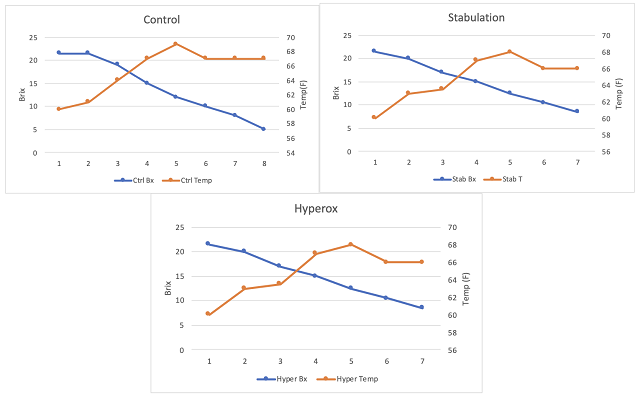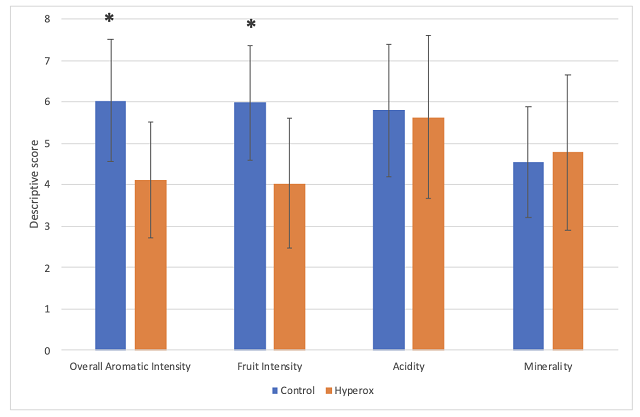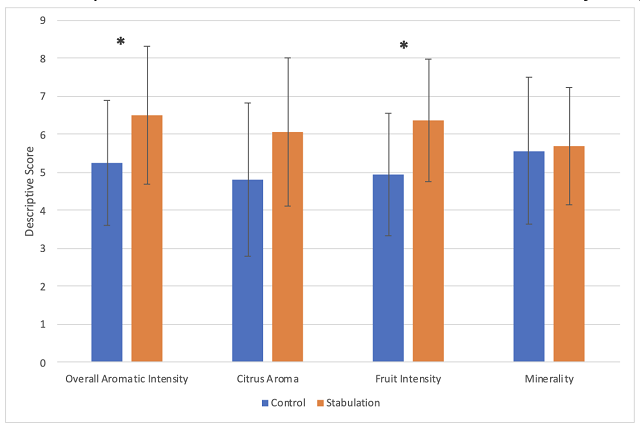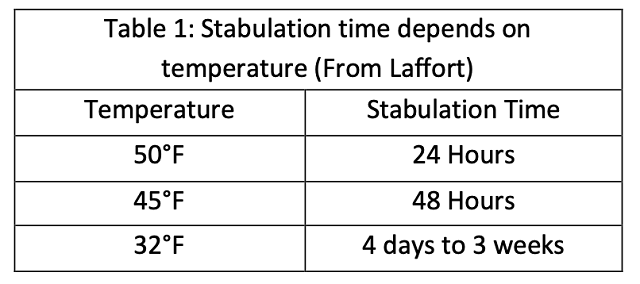Chemical and Sensory Impacts of Stabulation and Hyperoxygenation in Chardonnay
Theo Smith
Rappahannock Cellars
Summary
Chardonnay is the most commonly planted grape in Virginia, leading to the opportunity to experiment with different styles of production. Stabulation is a technique of stirring juice lees for several days to increase the extraction of flavor precursors from the pulp. Hyperoxygenation is the intentional enzymatic browning of juice that oxidizes phenolics to an insoluble form and removes them from wine to improve aging potential. In this trial, the same Chardonnay juice was treated with either stabulation or hyperoxygenation. Resulting wine chemistry and sensory effects were compared with a control that was neither stabulated nor hyperoxygenated. The most notable difference in chemistry was a shift in acidity from malic to lactic in the hyperoxygenated juice, likely due to lack of SO2 during treatment allowing partial malolactic fermentation. Both wines were significantly different from control in separate triangle tests. Hyperoxygenation of juice led to wine with significantly lower aromatic intensity and fruit intensity when compared to control while stabulation led to significant increases in these parameters.
Introduction
Chardonnay is the most commonly planted grape in Virginia, accounting for an estimated 19% of all Vinifera production and 20% of all bearing acres in the state in 20191. The abundance of available fruit leads to the opportunity to experiment with different styles of production, as many wineries produce more than one Chardonnay product. There are several winemaking techniques that can be used to produce different styles of Chardonnay. For example, in 2018, Rappahannock experimented with the use of skin contact in this variety2. Other possible approaches include stabulation to increase fruit expression and hyperoxygenation to increase minerality.
|
|
Stabulation is a technique of stirring juice lees for several days to increase the extraction of flavor precursors from the pulp. Originally developed in Provence for use in Rosé winemaking3, this technique has been shown to increase the aromatic extraction of thiol and ester precursors. When considering stabulation, it is important to hand harvest good quality fruit to prevent microbial activity and protect juice from oxygen with inert gas or dry ice to prevent oxidation of thiols. After pressing, lees are anaerobically stirred, often with CO2, to extract thiol and ester precursors. Wine is kept very cold to prevent fermentation, but low temperature also requires longer for extraction (Table 1). After juice has been stabulated, it is allowed to settle before racking, warming, and inoculation4.
One of the main aims of stabulation is the extraction of aromatic thiols, a specific class of sulfur containing compounds that are responsible for tropical fruit aromas. Though they are only present in low concentrations (they are measured in nanograms, which is 10-9 grams!), they also have very low detection thresholds5,6. Most often associated with Sauvignon Blanc varietal character5 (think broom, boxwood, cat pee, grapefruit), this class of compounds has also been shown to be important in the varietal character of Chardonnay, Petit Manseng, Merlot, Cabernet Sauvignon and Cabernet Franc, and Rosé among others7. A survey of 106 Australian Chardonnays found concentrations of thiols above the detection threshold in all of the wines tested, and some had concentrations as high as Sauvignon Blanc8. The July 2019 WRE Newsletter9contains a full review of aromatic thiols. Stabulation can also increase the concentration of esters in wine, which are significant contributors to fruit and floral aromas including apple, banana, pear, rose, and honey.Practically, stabulation also allows for sequential presses of fruit off a large vineyard as juice can be added to the tank over several days. It is expected that Chardonnay produced from stabulated juice would be a fruity, expressive style with notes of pineapple and citrus fruits.
Another technique that has been used widely in Chardonnay is hyperoxygenation. With the advent of premature oxidation in Burgundy, there has been a renewed interest in fining out phenolics at the juice stage through oxygen introduction. Wines produced from hyperoxygenated juice have been found to have less bitterness and astringency, and have better color stability during aging10. Some studies have found increases in aromatic intensity with hyperoxygenation while others have found decreases.
Hyperoxygenation is the intentional enzymatic browning of juice that oxidizes phenolics to an insoluble form and removes them from wine to improve aging potential. In practice, juice is not treated with SO2 during processing, which allows tyrosinase (polyphenoloxidase) enzymes to rapidly oxidize phenolics. Oxygen is intentionally introduced through pumping over, splash racking, or direct addition with compressed gas. Flavenoid phenolics extracted from skin during mechanical harvesting, sking contact, or pressing undergo polymerization reactions to form complexes that are insoluble in juice. Clean racking prior to fermentation removes the precipitated phenolics before they can resolublize in alcohol. Removal of phenolics at the juice stage can decrease the potential for browning later, and potentially decrease bitterness. However, some varietal aromas may be oxidized in the process, leading to lower aromatic intensity. The extent of the effect depends on the initial concentration of phenolics present and the extent of oxygenation10. Chardonnay treated with hyperoxygenation would be expected to have potentially lower overall aromatic intensity from oxidation of thiols, but higher scores for minerality and potentially less bitterness and browning over time.
Methods
Each treatment originated from the same harvest and press of Chardonnay grapes. Fruit was whole cluster pressed into a single tank. Free run juice only was used for this trial. Immediately after pressing, juice was mixed and racked again into three tanks. The control tank received 30 ppm SO2, was cold settled for 24 hours at 45°F (7°C), then racked to a stainless steel tank for fermentation. The stabulation tank was chilled to 32°F (0-2°C) for 3 days with daily anaerobic stirring followed by blanketing with CO2 (stabulation). After 3 days of stabulation, the tank was allowed to warm to 50°F prior to racking off lees. After racking, juice was transferred to a stainless steel tank for fermentation. Juice in the hyperoxygenation tank did not receive SO2. Immediately after racking, juice was pumped through a sump with splashing on return until juice was fully browned. Pumping proceeded for 60 minutes. Dissolved oxygen was measured before racking, before hyperoxygenation, and after hyperoxygenation. After hyperoxygenation, the tank was cold settled at 45 °F (7°C) for 24 hours, then racked into a stainless steel tank for fermentation.
After racking, juice in each lot was inoculated with 0.25 g/L Cross Evolution yeast (Scottlabs) rehydrated in 0.3 g/hL GoFerm. All subsequent cellar operations and additions remained the same among treatments. Fermentation kinetics (Brix and temp) were monitored and recorded daily. When wines completed fermentation, an addition of 30 ppm SO2 was made. Two days later, wines were racked off lees to stainless steel storage tanks. No malolactic fermentation was inoculated on these wines.
Sensory analysis was completed by a panel of 30 wine producers. Wines were presented blind in randomly numbered glasses. Tasters were presented with three wines, two of one type and one of another, and asked to identify which wine was different (a triangle test). There were three tasting groups with the unique wine in the triangle test balanced between groups. Two flights were presented: control vs. hyperoxygenated wine and control vs. stabulated wine. In the comparison of control vs. hyperoxygenated wine, tasters were asked to score each wine on a scale of 0 to 10 for overall aromatic intensity, fruit intensity, acidity, and minerality. In the comparison of control vs. stablated wine, tasters were asked to score each wine on a scale of 0 to 10 for overall aromatic intensity, citrus aromas, fruit intensity, and minerality. In each case, tasters were also given open ended questions to describe the wines. Results for the triangle test were analyzed using a one-tailed Z test. Descriptive scores were analyzed using repeated measures ANOVA.
Results
Initial juice chemistry was 21.4°Brix, pH = 3.32, TA=7.5 g/L. The initial dissolved oxygen prior to hyperoxygenation was 0.06 mg/L. After one hour of hyperoxygenation the dissolved oxygen of the juice was 3.2 mg/L. Juice was visibly darkened after one hour of hyperoxygenation, and remained so after racking while the juice from control and stabulated showed no evidence of browning after SO2 addition (Figure 1).
Fermentation kinetics were not notably different between the lots (Figure 2). However, finished wine chemistry showed marked differences in malic acid, lactic acid, and total acidity (Table 2), indicating partial malolactic fermentation. Hyperoxygenation itself has not been shown to have an effect on microbial growth10. Malolactic fermentation in the hyperoxygenated juice may have been more likely due to lack of SO2 addition coupled with increased exposure to cellar microbes during the time of treatment. The wine was pumped for a full hour through hoses and a sump cart. Malolactic bacteria resident in the winery may have had additional opportunity to colonize due to processing. To avoid malolactic fermentation in hyperoxygenated lots, SO2 can be added after racking off settled lees.
Figure 1: Juice was visibly darkened after one hour of hyperoxygenation (a) as well as after racking (b). Glasses are photographed with control, stabulated, hyperoxygenated juice.

Figure 2: Fermentation kinetics for three treatments of Chardonnay (in-house data)

Table 2: Final wine chemistry for three treatments of Chardonnay (IVC labs)

In a triangle test of control vs. hyperoxygenated wines, 19 out of 30 respondents were able to distinguish which wine was different, indicating the wines were significantly different (Z=3.29, p= 0.005). The control wine had significantly higher scores for overall aromatic intensity (F=16.05, p<0.001) and fruit intensity (F=6.33, p<0.001) while scores for acidity (F=0.11, p=0.737) or minerality (F=0.14, p=0.71) were not significantly different (Figure 3).
Figure 3: Descriptive scores for wines from control and hyperoxygenated juice (WRE)

In a triangle test of control vs. stabulated wines, 16 out of 29 respondents were able to distinguish which wine was different, indicating the wines were significantly different (Z=2.298, p= 0.011). The stabulated wine had significantly higher scores for fruit intensity (F=8.344, p=0.007) and overall aromatic intensity (F=6.522, p=0.016). Citrus aroma was also higher in the stabulated wine, though this was not a significant difference at the level of 0.05 (F=3.968, p=0.056). There was no significant difference in minerality (F=0.09, p=0.766)(Figure 4).
Figure 4: Descriptive scores for wines from control and stabulated juice (WRE)

References
(1) SMS Research Advisors. 2019 Virginia Commercial Grape Report. 2020.
(2) Smith, T.; Ting, J. Effect Of Short Skin Contact On Chardonnay Sensory Characteristics (2018). Winemakers Research Exchange, 2018.http://www.winemakersresearchexchange.com/library/2019/12/7/effect-of-short-skin-contact-on-chardonnay-sensory-characteristics-2018?rq=chardonnay
(3) Masson, G.; Schneider, R. Key Compounds of Provence Rosé Wine Flavor. Am J Enol Vitic. 2009, 60(1), 116–122.
(4) Report | ARC by Laffort.
(5) Benkwitz, F.; Tominaga, T.; Kilmartin, P. A.; Lund, C.; Wohlers, M.; Nicolau, L. Identifying the Chemical Composition Related to the Distinct Aroma Characteristics of New Zealand Sauvignon Blanc Wines. American Journal of Enology and Viticulture 2012, 63 (1), 62–72. https://doi.org/10.5344/ajev.2011.10074.
(6) Jackson, R. S. Wine Science: Principles and Applications, 4 edition.; Academic Press: Amsterdam, 2014.
(7) Tominaga, T.; Baltenweck-Guyot, R.; Gachons, C. P. D.; Dubourdieu, D. Contribution of Volatile Thiols to the Aromas of White Wines Made From Several Vitis Vinifera Grape Varieties. Am J Enol Vitic. 2000, 51 (2), 178–181.
(8) Capone, D.; Barker, A.; Osidacz Williamson, P.; Francis, I. The Role of Potent Thiols in Chardonnay Wine Aroma: Potent Thiols in Chardonnay Wine. Australian Journal of Grape and Wine Research 2017, 24. https://doi.org/10.1111/ajgw.12294.
(9) Ting, J. July 2019: Varietal Thiols in Wine. Winemakers Research Exchange, 2019.http://www.winemakersresearchexchange.com/newsletters-1
(10) Schneider, V. Must Hyperoxidation: A Review. American Journal of Enology and Viticulture 1998, 49(1).

